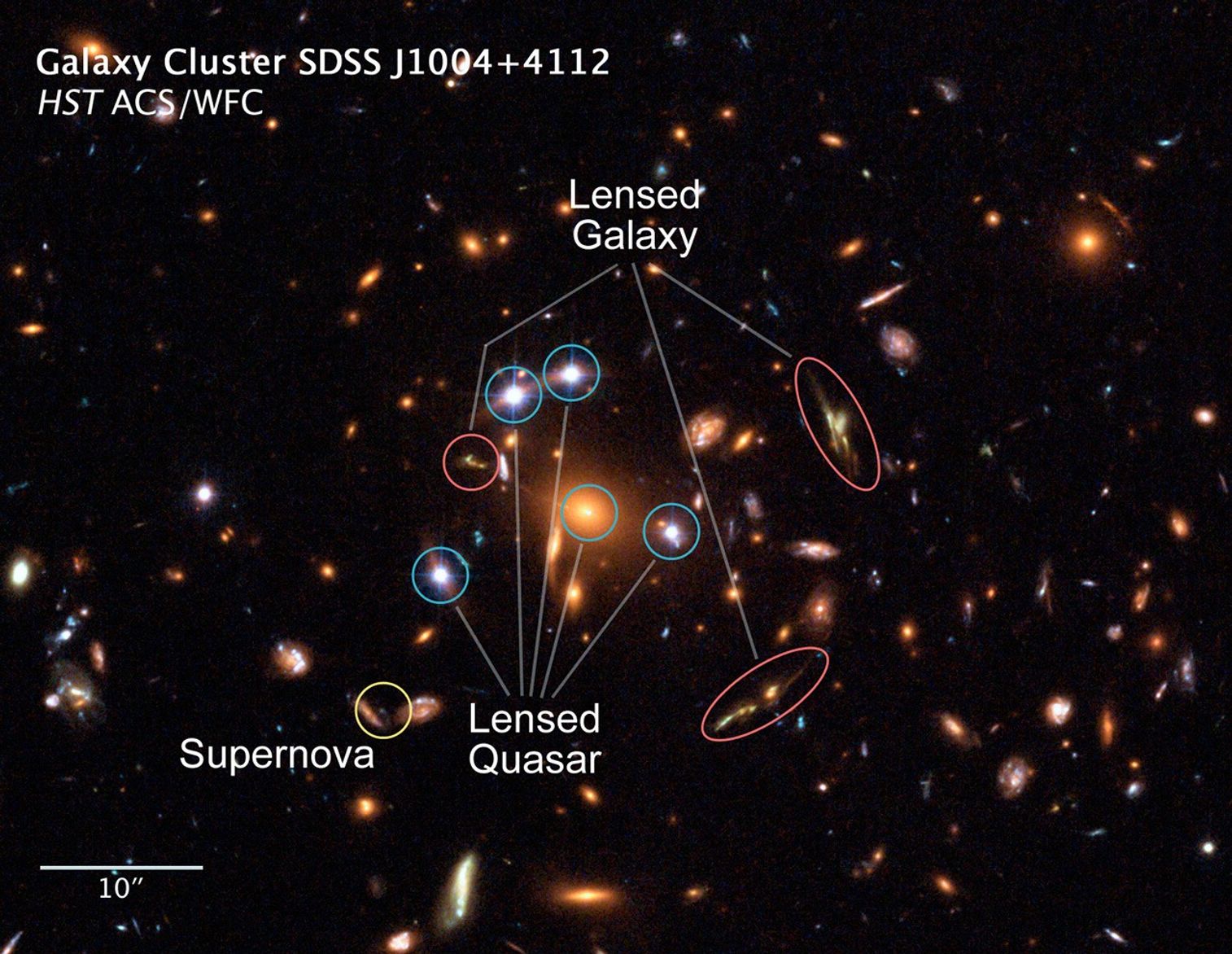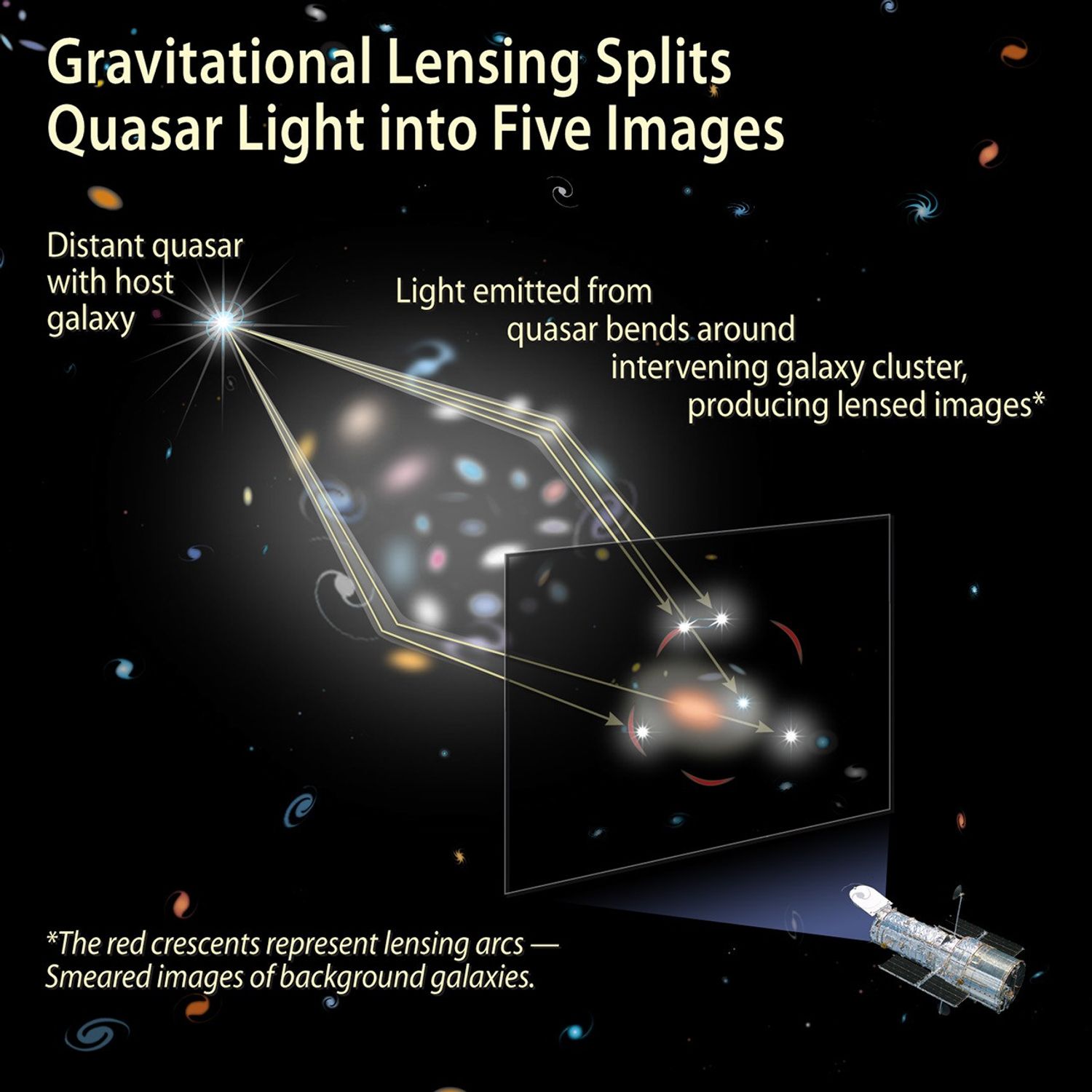1 min read
Hubble Captures a “Five-Star” Rated Gravitational Lens

NASA's Hubble Space Telescope has captured the first-ever picture of a group of five star-like images of a single distant quasar.
The multiple-image effect seen in the Hubble picture is produced by a process called gravitational lensing, in which the gravitational field of a massive object – in this case, a cluster of galaxies – bends and amplifies light from an object – in this case, a quasar – farther behind it.
Although many examples of gravitational lensing have been observed, this "quintuple quasar" is the only case so far in which multiple quasar images are produced by an entire galaxy cluster acting as a gravitational lens.
The background quasar is the brilliant core of a galaxy. It is powered by a black hole, which is devouring gas and dust and creating a gusher of light in the process. When the quasar's light passes through the gravity field of the galaxy cluster that lies between us and the quasar, the light is bent by the space-warping gravity field in such a way that five separate images of the object are produced surrounding the cluster's center. The fifth quasar image is embedded to the right of the core of the central galaxy in the cluster. The cluster also creates a cobweb of images of other distant galaxies gravitationally lensed into arcs.
The galaxy cluster creating the lens is known as SDSS J1004+4112 and was discovered in the Sloan Digital Sky Survey. It is one of the more distant clusters known (seven billion light-years away), and is seen as it appeared when the universe was half its present age.
Spectral data taken with the Keck I 10-meter telescope show that these are images of the same galaxy. The spectral results match those inferred by a lens model based only on the image positions and measurements of the light emitted from the quasar.
A gravitational lens will always produce an odd number of lensed images, but one image is usually very weak and embedded deep within the light of the lensing object itself. Though previous observations of SDSS J1004+4112 have revealed four of the images of this system, Hubble's sharp vision and the high magnification of this gravitational lens combine to place a fifth image far enough from the core of the central imaging galaxy to make it visible as well.
The galaxy hosting the background quasar is at a distance of 10 billion light-years. The quasar host galaxy can be seen in the image as multiple faint red arcs. This is the most highly magnified quasar host galaxy ever seen.
The Hubble picture also shows a large number of stretched arcs that are more distant galaxies lying behind the cluster, each of which is split into multiple distorted images. The most distant galaxy identified and confirmed so far is 12 billion light-years away (corresponding to only 1.8 billion years after the Big Bang).
By comparing this image to a picture of the cluster obtained with Hubble a year earlier, the researchers discovered a rare event – a supernova exploding in one of the cluster galaxies. The supernova exploded seven billion years ago, and the data, together with other supernova observations, are being used to try to reconstruct how the universe was enriched by heavy elements through these explosions.
About the Object
- R.A. PositionR.A. PositionRight ascension – analogous to longitude – is one component of an object's position.10h 4m 11.83s
- Dec. PositionDec. PositionDeclination – analogous to latitude – is one component of an object's position.41° 12' 50.4"
- ConstellationConstellationOne of 88 recognized regions of the celestial sphere in which the object appears.Leo Minor
- DistanceDistanceThe physical distance from Earth to the astronomical object. Distances within our solar system are usually measured in Astronomical Units (AU). Distances between stars are usually measured in light-years. Interstellar distances can also be measured in parsecs.The distance to the galaxy cluster gravitational lens is roughly 7 billion light-years (2.1 Gigaparsecs). The distance to the quasar being lensed is roughly 10 billion light-years (3 Gigaparsecs). The distance to the farthest galaxy being lensed into an arc is 12 billion light-years (3.7 Gigaparsecs).
- DimensionsDimensionsThe physical size of the object or the apparent angle it subtends on the sky.1.9 arcminutes wide
About the Data
- Data DescriptionData DescriptionProposal: A description of the observations, their scientific justification, and the links to the data available in the science archive.
Science Team: The astronomers who planned the observations and analyzed the data. "PI" refers to the Principal Investigator.This image was created from HST data from proposals: 9744: C. Kochanek (Smithsonian Institution Astrophysical Observatory), S. Myers (Associated Universities, Inc. ), I. Browne (University of Manchester), R. Blandford (California Institute of Technology), N. Jackson (University of Manchester), C. Keeton (University of Chicago), J. Munoz (Universidad de Valencia, Observatorio Astronomico), J. Lovell (CSIRO, Australia Telescope National Facility), L. Wisotzki (Astrophysikalisches Institut Potsdam), M. Gregg (University of California, Davis), D. Eisenstein (University of Arizona), D. Johnston (University of Chicago), N. Inada (University of Tokyo, Institute of Cosmic Ray Research), B. Pindor (Princeton University), S. Burles (Massachusetts Institute of Technology), G. Richards (Princeton University), E. Falco and B. Mcleod (Smithsonian Institution Astrophysical Observatory), P. Schechter (Massachusetts Institute of Technology), D. Rusin and J. Winn (Smithsonian Institution Astrophysical Observatory), L. Koopmans (Space Telescope Science Institute), C. Fassnacht (University of California, Davis), C. Impey (University of Arizona), H.-W. Rix (Max-Planck-Institut fur Astronomie, Heidelberg), and C. Peng (University of Arizona) 10509: C. Kochanek (The Ohio State University Research Foundation), M. Oguri (Princeton University), E. Ofek, K. Sharon, D. Maoz, and T. Broadhurst (Tel Aviv University - Wise Observatory), and N. Inada and Y. Suto (University of Tokyo, Institute of Astronomy). The science team studying this gravitational lens includes: K. Sharon (Tel Aviv University), E. Ofek (Tel Aviv University/Caltech), G. Smith (Caltech), T. Broadhurst and D. Maoz (Tel Aviv University), C. Kochanek (Ohio State University), M. Oguri (University of Tokyo/Princeton University), Y. Suto and N. Inada (University of Tokyo), and E. Falco (Harvard-Smithsonian Center for Astrophysics). - InstrumentInstrumentThe science instrument used to produce the data.HST>ACS/WFC
- Exposure DatesExposure DatesThe date(s) that the telescope made its observations and the total exposure time.April 28, 2004, January 2, 2005, and December 12-13, 2005, Exposure Time: 16 hours
- FiltersFiltersThe camera filters that were used in the science observations.F435W (B), F555W (V), F814W (I)
- Object NameObject NameA name or catalog number that astronomers use to identify an astronomical object.SDSS J1004+4112
- Object DescriptionObject DescriptionThe type of astronomical object.Galaxy cluster gravitational lens
- Release DateMay 23, 2006
- Science ReleaseHubble Captures a “Five-Star” Rated Gravitational Lens
- Credit

Share
Details
Claire Andreoli
NASA’s Goddard Space Flight Center
Greenbelt, Maryland
claire.andreoli@nasa.gov
































